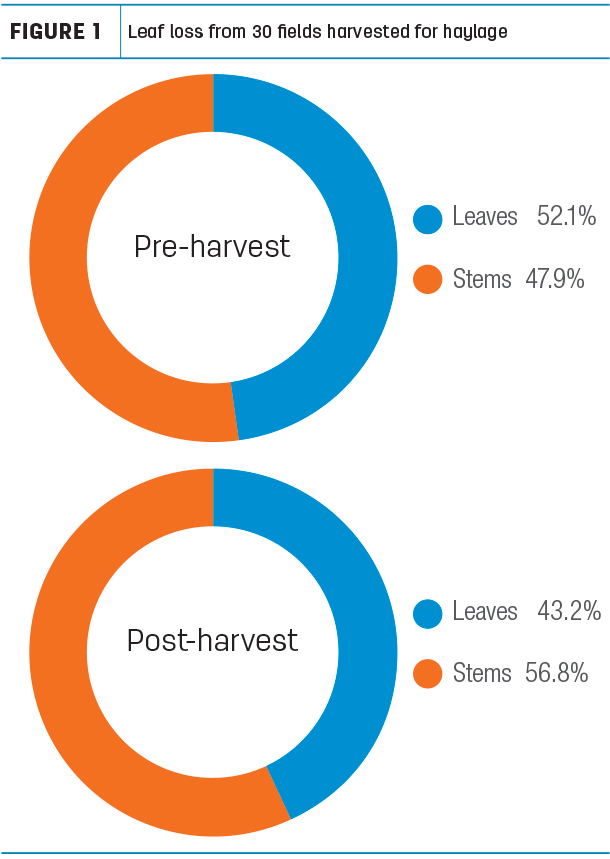We all know how important leaves are to forage quality.
Leaves contain the bulk of the energy and protein and are more digestible than stems. This is especially true for alfalfa.
Alfalfa is about 50% leaves and 50% stem when harvested at 27 inches high (often close to bud stage). Shorter plants will have a higher leaf percentage, and taller plants will have a lower leaf percentage (but more yield).
What is the leaf percentage of your harvested alfalfa? If the leaf percentage of your harvested alfalfa is significantly less than 50%, it is worthwhile to carefully examine your harvesting process to see where leaf loss is occurring. Remember, leaf loss represents both yield and quality loss.
Figure 1 shows leaf loss measured for 30 harvested fields, where the standing alfalfa and then the harvested haylage were both sampled and hand separated to determine leaf content.

The average leaf loss was 9%. However, one farmer lost 20% and another 24% of the leaves during harvesting.
Note also that this was alfalfa harvested for haylage, where we would expect the leaf (yield) loss to be less than when alfalfa is harvested for hay. A 9% yield loss during harvesting may be acceptable, but with dairy-quality hay selling at about $230 per ton, the average harvesting loss was about $20 per ton. Clearly the 20% or 24% leaf losses, costing $46 to $55 per ton, are not sustainable.
In addition to the harvesting yield loss, leaf loss represents a forage quality loss. In the above example, the 9% leaf loss also represents approximately a 20-unit relative feed quality (RFQ) loss, which can reduce hay value by up to $60 per ton. The farmers losing 20% and 24% leaves additionally suffered quality losses of 60 and 72 units RFQ.
What can be done to minimize leaf losses of alfalfa harvested for hay or haylage? Following are some losses that can be reduced:
• Condition with a roller conditioner, as flail conditioners cause 2% to 4% more leaf loss of alfalfa.
- Spread forage into wide swaths (cover at least 70% to 80% of cut area). The slower drying windrows respire more and burn off the starch and sugar, causing 4% to 6% dry matter loss. Note that starch is a 98% digestible fraction. Starch loss reduces leaf weight and is counted as leaf loss.
- Every time you move forage in field you create a leaf loss:
o Rake and/or merge once into windrows.
o Tedding or any additional forage movement will increase leaf loss.
- Moving forage at higher moisture content decreases leaf loss. The standard recommendation has been to move forage into windrows at 40% moisture. At this moisture, the alfalfa is ready to chop or bale for haylage or makes a sufficiently fluffy windrow to dry for hay harvest. However, making the windrow at 50% forage moisture will reduce leaf loss even further. Putting the hay into a windrow at higher moisture can also be beneficial to reduce leaf bleaching.
- Leaves on the surface of the swath (or later windrow) are drier than those leaves internal to the swath due to the drying effect of sunlight. Commercial haymakers often want to avoid bleached leaves for better visual appearance of bales (although this gives no nutritional benefits). However, bleached leaves are brittle and will often break apart during raking and merging and fall on the ground. Raking and/or merging before the surface leaves have fully dried (bleached), or with some dew to make the leaves less brittle, will help retain these leaves during windrow formation.
- Choose the type of rake and raking management to minimize leaf loss. Parallel-bar rakes and wheel rakes roll forage across the ground, shaking off leaves in the process. If using one of these, consider that rolling less distance across the ground is better – so a V-rake of either type, moving forage to the middle, is better than moving forage across two swaths to one edge. A rotary rake can minimize leaf loss if rotor speed is properly adjusted to ground speed. Also, consider that higher raking speed tends to increase leaf loss with all rake types. In our studies, a single raking can cause as little as 4% leaf loss to as much as 20% loss.
- When purchasing a merger, compare field operation of machines, as some mergers throw leaves and stems forward much more than others. Leaf loss (and dirt gain) are increased as the pickup is set lower – try to manage windrow so pickup tines do not touch the ground. Also, throwing forward is increased as ground speed is increased.
- Similarly, watch the hay pickup on the baler or chopper. A 5-bar pickup on round balers has less leaf loss than the 4-bar pickup. Similar differences exist for large bale and chopper pickups.
- Lastly, walk alongside the baler or chopper and notice how much “green” loss is occurring in the harvesting process. This green is largely leaf loss. Small square balers are notorious for having a layer of fines come out the back of the baler from under the bales. This loss is reduced with larger balers that feed straight through into the bale. Losses occur with round balers as particles fall off the rotating bales between the belts. Less loss occurs as the hay is wetter, which is why baleage tends to be higher quality than dry hay. However, even when chopping haylage, recognize that the “green cloud” represents leaf loss.
- As with raking, leaf shattering and loss can be reduced during baling with some dew on the hay. This is why some Western haymakers bale overnight or in the very early morning. Some Western haymakers use steamers when baling, which also can toughen the hay to reduce leaf loss. Chopping haylage with some dew can also reduce the green cloud (leaf loss).
In summary, begin by examining your hay, baleage or haylage – do you have close to 50% leaves? If so, then your machinery decisions have been good, and maintenance and management of the harvesting process is very good. Significantly less than 50% leaves sometimes may indicate unfavorable conditions, but, if consistent across harvests, changes to equipment and/or operating procedures may result in significant yield and quality increases.










